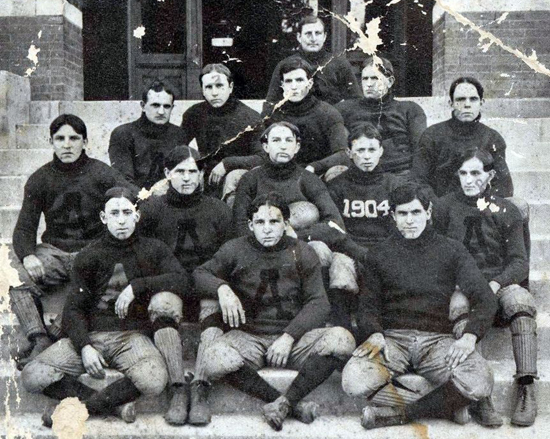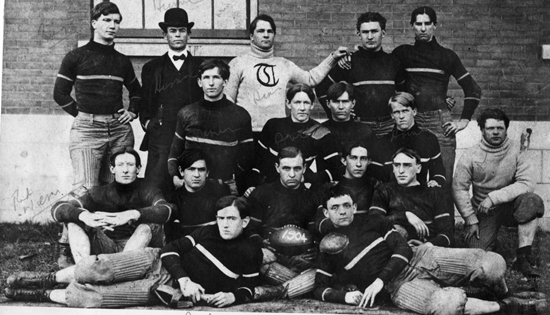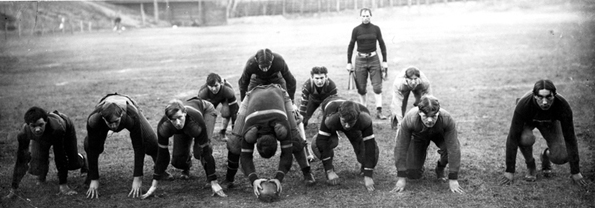Clash of Titans
Games featuring a future Hall of Fame coach on each sideline.
October 29, 1904: Georgia Tech @ Auburn
John Heisman vs Mike Donahue
After having three football coaches in four seasons, Auburn hired 28-year-old Mike Donahue, born in County Kerry, Ireland, to take over the program in 1904. He played quarterback for the legendary Walter Camp at Yale from 1899-1903. Camp coached his players to hit hard and think hard. Donahue based his coaching on the same principles.
The crowd that gathered at the Auburn train station to greet their football savior was not impressed by the 5'4" tall man who stepped onto the platform. He looked more like a cheerleader than a coach. As Donahue remembered years later, "They were the most disgusted bunch of people I've ever seen." Adding to his woes was his mixture of northern and Irish dialect that the locals had difficulty understanding.
His task was daunting. As Zipp Newman explained in 1969, "Auburn had an enrollment of 200. Donahue didn't have five high schools in Alabama to draw on for players. He had no coaching staff, recruiters, football game pictures and little if any money in the treasury to buy much equipment—and there were rocks on the practice field."
But Donahue didn't inherit a bare cupboard. He went to work with the players returning from the 4-3 team of 1903. However, to increase the roster, he took raw-boned boys, many of whom had not played high school football, and started molding them into hard-hitting, smart players. Some of the newcomers had never even seen a football game, including star end Clyde "Hard Boy" Pruitt.
One technique that Donahue learned from Camp and taught to his Auburn players was the dragging tactic when one of his men was tackled. "No sooner was a runner thrown than his teammates rallied around him, dragging him often five or ten feet before being checked."
One of the players on Donahue's first Auburn team is credited with changing the center snap. As Mike explained to Newman decades later, "There is one spiral pass that to the best of my knowledge originated at Auburn, and that is the spiral pass from center. A center named Doc Bartlett sprung it on me in 1904. I was showing the end over end pass which was universally used at the time and for many years afterwards. Doc was not doing very well so he asked me to let him try his way. He had as good a spiral pass from center as I ever saw and its advantages were obvious, especially for kicks. We never used anything else after that."
The Tigers not only won their first three games, they shut out Florida, Clemson, and Nashville. Then Georgia Tech came to Auburn. Not known as the Yellow Jackets until the 1905 season, Tech was led by first-year coach John Heisman, who had directed Auburn to a 12-4-2 record from 1895-99 before moving to Clemson for four years. Tech was 5-0, outscoring their opponents 176-5. Like Donahue, Heisman learned football in the Northeast at Pennsylvania.
The loser of the Auburn-Tech game would drop with a thud from a tie with Vanderbilt and Sewanee for the top spot in the Southern Intercollegiate Athletic Association.

1904 AUBURN TEAM
Coach Mike Donahue has 1904 on his sweater.
(Alabama Polytechnic Institute Varsity Football Team 1904 postcard)
Auburn was heavier in both the line and backfield than Tech. Add that edge to home field advantage, and you have the Tigers as the clear favorites. To make matters worse for the visitors, four of Tech's best players, including fast RE E. C. Davies who called the signals, were battling injuries.
The Atlanta Journal article on the game started like this: "By hammering Tech's line from tackle to tackle unmercifully and with never a let up in the battering ram process, Mike Donahue's crack Auburn delegation trailed Tech's colors in the dust today by the score of 12 to 0."


1904 GEORGIA TECH TEAM
Notice in the bottom picture the roundness of the football and the left end split out slightly.
Heisman in the back. (Georgia Tech Archives)
"When the battle opened at 3 p. m., the crowd around the field was the largest that ever attended a game in Auburn." Both touchdowns were scored in the first half.
Auburn Marches Length of Field
The game opened with a punting duel between Humphrey Foy of Auburn and Lob Brown of Tech. The Georgians gradually improved their field position until they took possession at midfield. Consecutive plunges put the ball on the 20, but the Orange and Blue line stiffened and held for downs at the five.
Obeying the new rule requiring teams to have six men on the line of scrimmage, the Tigers used the "tackles back formation" that put two big tackles in the backfield about one yard behind the guards with the backs placed another three yards behind them. Running repeatedly out of that formation, Auburn marched 105y to their first touchdown, with Frank Jones gaining the final yardage. The longest gain was 10y. Foy kicked the extra point to make the score 6-0.
Tigers Double Their Lead
Under the rules of the day, Tech kicked off, and once again the home team put their "Yale machine" in motion. The Tigers' "powerful and well trained forwards opened up holes big enough to allow the distance (for a first down) always, and the Tech line was beaten back. These tackle masses and terrific line plunges carried the ball over for a second touchdown." Once again, Jones scored, and Foy kicked goal to make it 12-0.
Heisman gave his team a severe "talking to" during the ten-minute intermission. Any defensive changes he made paid off because neither team threatened in the second half.
Heisman, "the premier coach of the South," declared that no team in the South with the possible exception of Vanderbilt could pierce the extraordinary defense of the lads of Alabama Polytechnic Institute.
Two weeks later, Auburn completed its undefeated season by beating Georgia in Macon 17-6.
References
History of Southern Football 1890-1928, Fuzzy Woodruff (1928)
The Impact of Southern Football, Henry "Zipp" Newman (1969)
Where Tradition Began: The Centennial History of Auburn Football, Wayne Hester (1991)
Stadium Stories: Auburn Tigers, Phillip Marshall (2005)
History of Southern Football 1890-1928, Fuzzy Woodruff (1928)
The Impact of Southern Football, Henry "Zipp" Newman (1969)
Where Tradition Began: The Centennial History of Auburn Football, Wayne Hester (1991)
Stadium Stories: Auburn Tigers, Phillip Marshall (2005)